This week the Goonhammer Historicals team continues its focus on the American Civil war, taking a deeper dive into some of the unusual, unique, or just downright bizarre units that took part in the conflict. Whether from the standpoint of being interesting or fun to paint, bringing an unusual aspect to wargaming scenarios, or being just plain fascinating to learn about, these are a couple of stand-out units that we thought it would be fun to highlight.
Perhaps you’ve been painting up your ACW forces for a while and have grown tired of serried ranks of Prussian Blue jackets and kepis. Or maybe you’re looking around for new material for skirmish actions in the period. Or maybe you want to put a little extra punch into your cavalry units. If you’re looking for something new and different, chances are good that some crazy colonel or general in the Civil War actually tried it at some point in time, so let’s take a look at a couple of “special” units from the American Civil War and what made them interesting.
Ilor’s Picks
The Iron Brigade
As a proud Michigander, I’ll start us off with one that’s near and dear – the Iron Brigade, which was formed of units from three states in the Midwest. Originally just the 2nd, 6th, and 7th Wisconsin Regiments, it grew to include the 19th Indiana Regiment and the 24th Michigan Volunteers. The brigade served with distinction at the second battle of Bull Run, as well as at Antietam, Fredericksburg, Chancellorsville, Gettysburg, Mine Run, Overland, Petersburg, and Appomattox. The regiment got it’s name for its gallant and inexorable advance against Confederate forces during combat at Turner’s Gap, a prelude to the bloody fighting at Antietam. But in addition to having a well earned reputation as hard-asses, the brigade had another moniker as well – “The Black Hat Brigade” (or sometimes just “The Black Hats”), so named for their distinctive black Hardee hats.
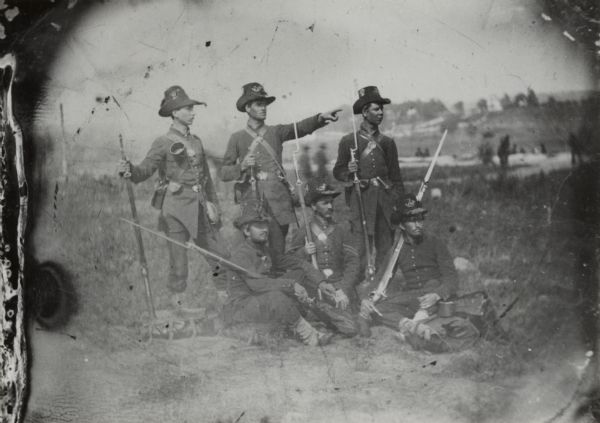
The brigade anchored the southern end of the Union line at Seminary Ridge and the northern flank of Culp’s Hill at Cemetery Ridge, stubbornly refusing to give ground in both cases. Being rock-hard took its toll, however. As a combined unit, the Iron Brigade as a whole sustained the most casualties of any brigade in the entire American Civil War. At the battle of Gettysburg alone, the unit lost 1153 out of 1885 men killed or wounded, a casualty rate of 61% overall. Of the five regiments of the Iron Brigade on the field those three days, the 2nd Wisconsin suffered a 70% casualty rate and the 24th Michigan a staggering 80% of its men killed or wounded.
Aside from the home state connection, what makes the Iron Brigade interesting for me is that they’re still Union troops and therefore easy to paint, but for real the hats are just fun. In addition to the one upturned brim, they have a tassel as well. In accordance with Union army regulations of the time, these tassels were sky blue to denote an infantry unit. This is one of those little visual historical details that is a treat to paint and gratifying to see on the tabletop.
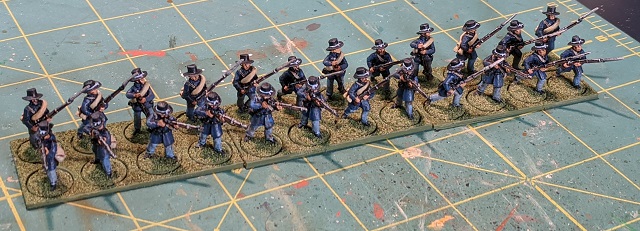
Berdan’s Sharpshooters
First organized by Colonel Hiram C. Berdan in 1861, the 1st US Sharpshooters was a specialized unit comprised entirely of volunteers. Standards for admission to the unit were high – each qualifying candidate had to be able to place ten shots into a 10-inch circle from a range of 200 yards over open sights. Originally formed of men from Albany and New York City, the regiment soon swelled with men from more remote frontier areas in states like Vermont, New Hampshire, Michigan, and Wisconsin.
Initially, many of the unit’s marksmen used their own weapons, often with telescopic sights. This lack of ammunition uniformity caused operational supply headaches, however, and ultimately led to Berdan requesting the unit be outfitted with the breech-loading Sharps Rifle (which was considered accurate to 600 yards). The request was initially blocked by Lt. General Winfield Scott out of a fear that the rapid-firing breech-loading weapons would lead to ammunition wastage. Appealing the decision all the way to President Abraham Lincoln (who was impressed by a demonstration of the rifle’s capabilities in the hands of a trained sharpshooter), the requisition was finally approved and the new rifles were issued to the unit.
One of the aspects that makes Berdan’s Sharpshooters an interesting unit to paint is the fact that their uniforms were of a dark green wool rather than the standard issue light blue trousers and dark blue jackets. Additionally, the uniforms were not allowed any brass buttons. This makes for an interesting diversion after you’ve painted a veritable horde of regular infantry, but as the war dragged on, replacement uniforms in the original green became harder to obtain and more and more were replaced with the standard-issue dark blue. This gives you the option to do a “mix-and-match” unit that has a nice, irregular feel to it.
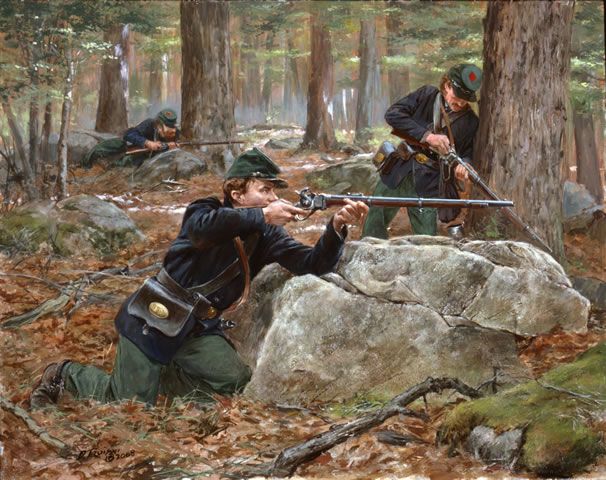
From a wargaming context, what really sets Berdan’s Sharpshooters apart was the way they were used on the field. Skirmishing at long range and engaging in what we now recognize as guerilla warfare, these men often moved and fought in relatively small groups. As such, they are perfect forces for smaller, skirmish-scale rules like Sharp Practice. If you’re looking for a break from the “rank and flank” action of larger battles, painting up a small number of miniatures as Berdan’s Sharpshooters opens up a whole world of small-scale scenarios like bold raids, vicious harassing actions, and desperate escapes. Like the notorious British 95th Rifles of the earlier Napoleonic Era, daring escapades await such a unique and specialized unit on the tabletop.
1st Louisiana Special Battalion
No account of flamboyant American Civil War units can be complete without mention of the “1st Louisiana Special Battalion,” also known by a host of other names such as the “Louisiana Tigers” or “Wheat’s Tigers.” Originally recruited by the notorious Major Chatham Roberdeau Wheat, the first four companies of the unit were comprised largely of poor Irish immigrants who had found work in New Orleans as stevedores, rivermen, ship hands, stokers, and draymen – labeled by one observer as “the lowest scum of the lower Mississippi…adventurous wharf rats, thieves, and outcasts…and bad characters generally.” Another opined that the Tigers were “the worst men I ever saw…. I understand that they are mostly wharf rats from New Orleans, and Major Wheat is the only man who can do anything with them. They were constantly fighting with each other. They were always ready to fight, and it made little difference to them who they fought.” Wheat himself was a veteran of the Mexican War and in the 1850s had done work as a “filibuster,” the name given to men who undertook unsanctioned military adventures in foreign countries. In particular, Wheat had caused a fair amount of trouble in Nicaragua.
Comprised of a motley crowd of ne’er-do-wells, the unit had a reputation as a hard-drinking, hard-fighting outfit even before it’s first action at First Manassas. Success there earned the unit a reputation for pugnaciousness that was only reinforced during Jackson’s Shenandoah campaign during the spring of 1862. This was particularly the case at the battle of Front Royal, where elements of the battalion crossed a burning bridge under fire to capture a Federal supply train. Ballsy!
What makes this unit interesting on the tabletop is without a doubt its uniforms, and I use that word loosely. Each of the initial four companies had a different look. Most wore red flannel “Garibaldi” shirts. Company B covered these with dark blue vests with red piping, whereas Company C (also known as “Chaffin’s Rough and Ready Rangers”) were apparently issued grey jackets, trousers and kepis, though straw boater hats were de rigeur throughout the battalion. But the real killer combination was Company A (“White’s Tiger Rifles”), who were outfitted in full Zouave fashion with the signature red shirts and blue jackets, but combined this with blue-and-white vertically striped pantaloons and white gaiters. Their stockings were also blue-and-white striped, but horizontally just to mix things up. Tasseled red fezzes were also issued, though many men kept their boater hats. Oh, and did I mention that because the units were initially equipped with rifles (helpfully “liberated” from a Federal arsenal after secession) lacking bayonets that the men pretty much universally carried heavy cutlasses or large bowie knives?
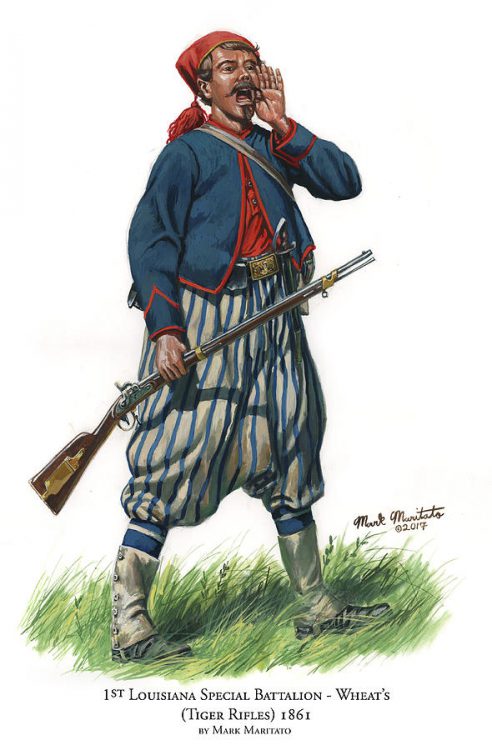
You would think that an outfit this outlandish would stand out on the field, but the blue jackets actually caused unfortunate friendly fire incidents at First Manassas. Thus, prior to departing to join Jackson’s force in the Shenandoah, the men of the battalion re-dyed their jackets a ruddy grey brown (almost certainly using walnut shells as described on our earlier article on painting Confederates). With so many different colors, patterns, and textures, this unit is a painter’s dream and will look incredibly unique and distinctive on the field. And given that it was formed of rough-and-tumble men – many of whom were veterans of foreign wars – if you’re looking for a unit with a well-deserved reputation as elite veterans well-disposed to close quarters fighting, these are your guys.
Mississippi Marine Brigade
The American Civil War was notorious for “self-made men” ending up in positions of leadership and authority. Colonel Charles Ellet, Jr. was no exception. A Civil Engineer who made his name designing canals and suspension bridges, Ellet became interested in steamships in the 1850s. In particular, he became convinced that fast ram ships could be powerful naval weapons. Traveling abroad while the Crimean War was underway, Ellet offered his services to the Russian government for a plan to help break the blockade of Sevastopol, but the assassination of the czar cut those plans short. As early as 1855 he was pitching the idea of a fast fleet of ram vessels to the US Navy, but could get no traction for his ideas.
With the outbreak of hostilities between the United States and the Confederacy, he once again began proselytizing to anyone who would listen. The Navy establishment largely blew him off, but in March of 1862 US Secretary of War Edwin M. Stanton (who was familiar with some of his earlier engineering works) gave him a shot. Ellet was given a colonel’s commission and ordered to go forth and create a fleet of fast ram vessels. This Ellet did, purchasing nine of the fastest paddle-wheeled steam boats on the Ohio river and converting them to light, fast, “cottonclad” rams (so named because they were “armored” with bales of cotton piled on their decks).

Because the project was conducted outside of the auspices of the US Navy, the unit (dubbed the United States Ram Fleet) operated outside of the naval chain of command and reported directly to the Secretary of War. This caused problems of coordination, but the ram fleet performed spectacularly at the battle of Memphis on June 6, 1862. Charles Ellet Jr himself was killed in this battle (the only Union casualty), at which point command of the Ram Fleet devolved to his brother Alfred W. Ellet. Did I mention that the Ram Fleet was a hive of nepotism, with no fewer than four Ellet’s in command at various times?
Control of the Mississippi River was seen by both sides as key to winning the war, and the lynchpin of that control was the city of Vicksburg Mississippi. General Ulysses S. Grant’s nearly year-long campaign to capture that city depended heavily on the Mississippi River as a supply route. Unfortunately, even though the US Navy (with the aid of the Ram Fleet) established control of much of the waterway itself, there was no easy way to stop Confederate irregulars from setting up a cannon or two on the banks of the river and shelling the vital steamships bringing supplies to Union armies in the field – by the time infantry or even cavalry was dispatched to the area, the Confederates were long gone. In November of 1862, Ellet was charged with forming the Mississippi Marine Brigade. This was a “combined arms” unit of infantry, cavalry, and artillery that used the ships of the Ram Fleet as transport, the idea being that they could travel with the transport ships and provide a fast counterstrike force. The unit comprised some 350 men (though this included the ships’ crews) and like its parent Ram Fleet was outside of the regular US Army chain of command. As a completely separate organization, the Brigade was not allowed to recruit men from the regular Army or Navy, instead recruiting heavily from convalescent hospitals and among men whose regular service was over.
Take a moment to digest that – this is regiment-sized amphibious attack force commanded by one man that answers only to the Secretary of War, effectively a private army taking part in the conflict. At any point along the river, Ellet’s raiders could roll up, drop a gang-plank, and start deploying troops. Even as late as October of 1863 (long after the capture of Vicksburg and total Union control of the Mississippi River), Grant complained that the Mississippi Marine Brigade was not subject to his orders. Finally, in August of 1864 the unit was disbanded and the ships of the Ram Fleet turned over to the Navy for other duties.
From a wargaming perspective, the Mississippi Marine Brigade offers amazing opportunities for mayhem. Though it was in operation for less than two years, it engaged in several battles and countless smaller raids and skirmishes, any of which could provide for a fun and challenging wargaming scenario. Better still, they often operated in terrain that was inaccessible to larger formations – lowlands, levees, cypress swamps, and heavily-wooded bayous. This opens up all sorts of interesting terrain options that will bring a new set of challenges to the tabletop. Further, the amphibious nature of the unit means you can combine games – say playing a game of Scary Biscuit’s Ironclads game to play out the riverine part of an engagement, then transitioning to Sharp Practice once the troops are landed! And of course from a historical perspective, the idea of one crazy engineer’s brainchild leading to a private army marauding up and down the Mississippi River is just fascinating. It’s one of those period oddities that makes the American Civil War such a compelling conflict.
Mugginns’ Picks
The Orphan Brigade
Known as the ‘Kentucky Confederates who couldn’t go home’, the First Kentucky Brigade, better known as the Orphan Brigade, was organized in 1861 and fought in many engagements in the Western theater. Because Kentucky was a border state that remained with the Union, officers camped in Tennessee and traveled back into Kentucky to recruit. Originally it was composed of the 2nd, 3rd, 4th, 6th, and 9th Kentucky regiments but later accepted in the 5th Kentucky, 41st Alabama, and 31st/49th Alabama. One interesting note is that the rush to recruit and organize meant the 9th Kentucky originally started as the 5th Kentucky but had to change once they released there was another 5th Kentucky regiment. The brigade was originally commanded by John C. Breckinridge, former Vice President of the United States, who would go on to become a corps commander at Shiloh and later hold many different positions, including commanding at New Market in Virginia.
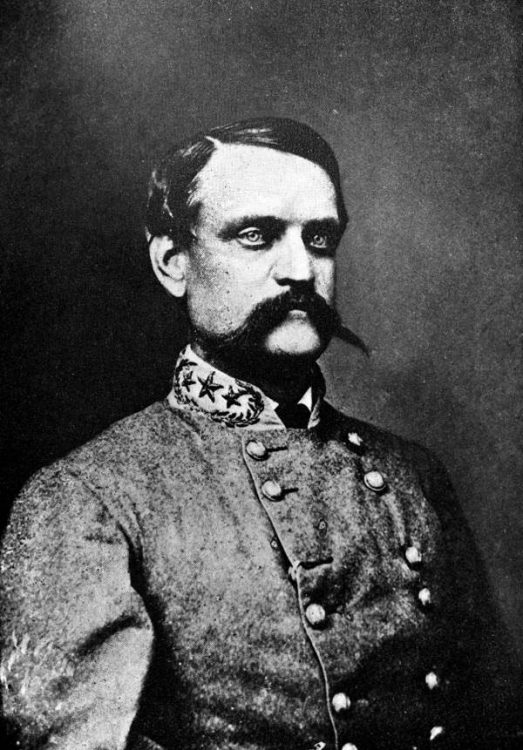
The Orphan Brigade saw their first action at Shiloh, engaging in hard fighting at the Hornets Nest. They lost 844 men out of 2,400 that entered the battle in service. They were then moved to Vicksburg to defend there. Later in 1862 they fought at the battle of Stones River, engaging in a suicide charge ordered by hated General Braxton Bragg (Sam Watkins, private soldier in the Army of Tennessee called him a “a merciless tyrant” who “loved to crush the spirit of his men”), losing nearly one third of the brigade after being hammered by 45 artillery pieces arrayed hub-to-hub firing down on them. They assaulted Union lines at Chickamauga, losing their brigade commander and brother-in-law to Abraham Lincoln, Benjamin Hardin Helm. After the defense of Atlanta, they were converted to mounted infantry to fight the rest of the war against Sherman’s march to the sea.
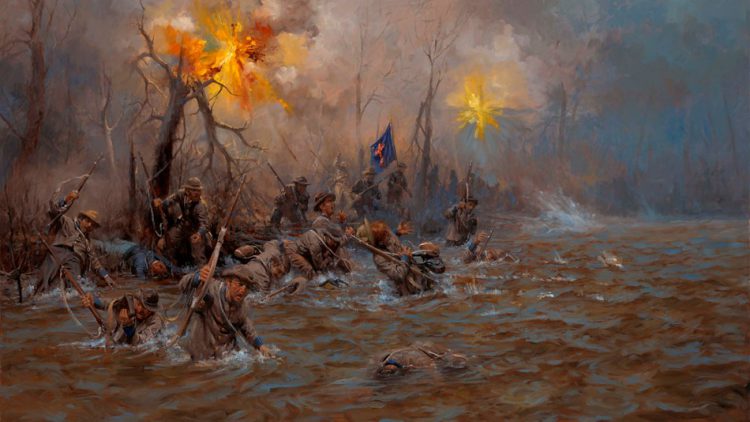
So why paint and play with the Orphan Brigade? They weren’t necessarily an elite unit, but they are different. They have an interesting story, being a brigade that couldn’t recruit replacements nearly as much or take leave to go home. It is useful to paint units from the western theater, as much of the focus in wargaming, especially on the Confederate side, is on the east and the Army of Northern Virginia. Their uniforms differed greatly from Eastern armies as they wore grey wooljean with blue edges to their sleeves and pants. They provide an opportunity to model not just mounted troops, but mounted infantry, which doesn’t get as much attention in wargaming.
Wilder’s Lightning Brigade
Composed of three units of Illinois and two units of Indiana mounted infantry, Wilder’s Lightning Brigade is another Western Theater unit that fought at Chickamauga. They were mounted as a result of infamous Confederate raider John Hunt Morgan’s raids into Kentucky, Indiana, and Ohio. Early on they were mounted in wagons, but this was seen as too slow. So after much prodding by General William Rosecrans and their commander Colonel John Wilder, they were first mounted on mules and then mounted on horses requisitioned as contraband from local Tennessee farms.
What makes this brigade different is they fought as mounted infantry – even being equipped with hatchets instead of cavalry sabers. They would ride to a location in battle, dismount, and fight as infantry. This earned them their nickname of the ‘Lightning Brigade’. Wilder secured loans from a bank in Indiana so each man could purchase his own Spencer repeating rifle. These proved especially deadly at Chickamauga where the brigade rode to the defense of Union lines on both days of the battle.
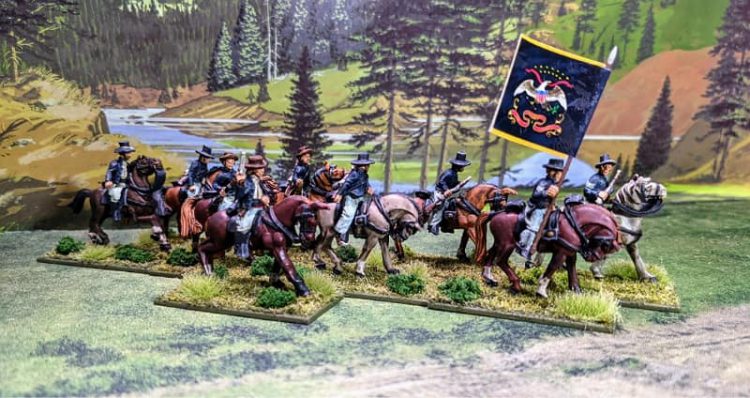
When modeling these soldiers for gaming, regular cavalry models aren’t a great choice, as these men wore infantry uniforms and carried repeating rifles. I heartily recommend the 28mm line from Sash and Saber miniatures. They carry both the mounted models and dismounted models, making a great choice for an interesting addition to your forces.
Mosby’s Rangers
Of particular interest for Sharp Practice, Mosby’s Rangers would make a great partisan force with both mounted and dismounted troops. They’re more famous than my other two selections, there are plenty of books and sources on Mosby and his men. I would suggest Yank and Rebel Rangers: Special Operations in the American Civil War by Col. Robert Black. It could have been edited better but it has a plethora of great accounts of actions involving rangers during the war.

One of the more interesting and lesser reported actions that happened during the war was the use of enemy uniforms by both sides’ rangers. It could make an interesting scenario where Mosby’s Rangers have infiltrated one group in Union blue. I’d have to figure out how to make rules for it as I haven’t seen any before. Of course the other scenarios we could use would be raiding actions – that was their primary activity every day. They’d raid behind enemy lines, grabbing supplies, cash, and livestock then melt back into the population, wearing civilian clothes and hiding out at homes in the area.
When selecting minis for this unit, most Confederate cavalry would be fine, but you’d want to make sure they are armed only with pistols. Despite Mosby’s photo above his unit had a penchant for two Colt revolvers in close quarters combat, discarding their sabers at first chance. If you’re going for a full force of partisans, you’d want probably four mounted groups of partisans and four groups of infantry that would count as dismounted cavalry for the entirety of the game. This will give you a good variation of forces and you might also include a small artillery piece they’ve brought up to fight with.
One of the most compelling things about Mosby’s Raiders is that after the war, Mosby became a Republican, supported Uylsses S. Grant, and fought against the Lost Cause mythology. His memoirs included a ton of support for J.E.B. Stuart who was maligned as the failure that caused Robert E. Lee’s loss at Gettysburg. He fought against the idea that the war wasn’t about slavery and wrote many letters trying to stamp it out.
If you have any interesting units or commanders that you think are underrepresented on the tabletop or would make a great research topic, please let us know in the comments! Or shoot us an email at contact@goonhammer.com.


